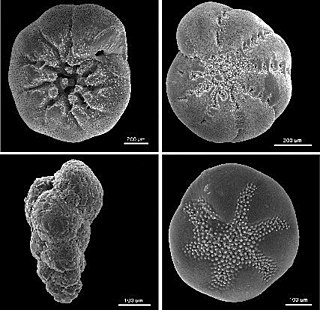Les Rhizaires aussi appelés Rhizariens[1] (ou Rhizaria) sont un groupe d'organismes eucaryotes, le plus souvent unicellulaires. Ils peuvent vivre dans des eaux oligotrophes en s'associant symbiotiquement à des algues[2].
| Clade | Diaphoretickes |
|---|---|
| Sous-règne | Harosa |
Embranchements de rang inférieur
Biomasse
Leur biomasse a longtemps été très sous-estimée, car ils sont si fragiles que le filet à plancton les détruit. Une méthodes d'échantillonnage non destructive (par caméra immergée) a permis en 2016 de réévaluer l'importance du super-groupe des Rhizaria : ces protistes représentent 33 % de l'abondance totale du plancton animal de grande taille à l'échelle de l'océan mondial et contribuent à 5 % de la biomasse marine globale[3].
Description
Les Rhizaires ont une morphologie amiboïde.
Classification
Parce qu'ils ont une forme amiboïde, ils ont été historiquement classés parmi les Amoebozoa.
Leur positionnement a été hésitant puisqu'on les a également présentés comme groupe frère des Excavata[4] puis des Straménopiles[5] (ou plus précisément les Halvaria).
Selon ce dernier point de vue il s'agit d'une division, non plus des Chromistes, mais du sous-règne des Harosa.
Selon World Register of Marine Species (21 juillet 2017)[6] :
- Embranchement des Cercozoa
- Embranchement des Foraminifera
- Embranchement des Radiozoa
Phylogénie
Rhizaria est un groupe monophylétique composé de deux embranchements frères : Cercozoa et Retaria. Par la suite, Cercozoa et Retaria sont également monophylétiques[7],[8]. Le cladogramme suivant décrit les relations évolutives entre toutes les classes rhizaires et est réalisé d'après les travaux de Cavalier-Smith et al. (2018)[9], Irwin et al. (2019)[10] et Sierra et al. (2022)[11] :
| Rhizaria |
| |||||||||||||||||||||||||||||||||||||||||||||||||||||||||||||||||||||||||||||||||||||||||||||||||||
| Halvaria |
| |||||||||||||||||||||||||||||||||||||||||||||||||||||||||||||||||||||||||||||||||||||||||||||||||||
Galerie
- Ebria sp. (Cercozoa : Ebridea)
- Rhipidodendron sp. (Cercozoa : Spongomonadea)
- Euglypha sp. (Cercozoa : Euglyphida)
- Phaeodarians (Cercozoa : Phaeodarea)
- Clathrulina elegans (Cercozoa: Granofilosea : Desmothoracida)
- Vampyrella sp. (Cercozoa : Vampyrellidae)
- Gromia (Cercozoa : Gromiidea)
Références
À lire aussi
Liens externes
Wikiwand in your browser!
Seamless Wikipedia browsing. On steroids.
Every time you click a link to Wikipedia, Wiktionary or Wikiquote in your browser's search results, it will show the modern Wikiwand interface.
Wikiwand extension is a five stars, simple, with minimum permission required to keep your browsing private, safe and transparent.













